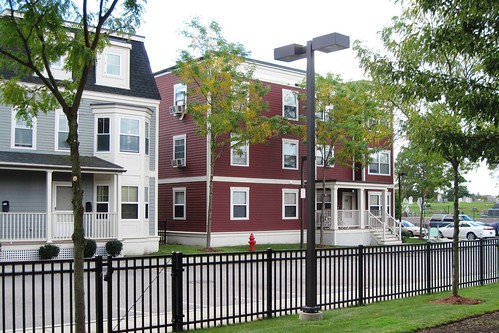Massachusetts takes a step for smart neighborhoods, workforce housing

Posted November 20, 2012 at 1:36PM
Last week, Massachusetts governor Deval Patrick announced a new policy initiative designed to encourage diverse, walkable neighborhoods that use land efficiently. If a municipality meets certain criteria, it will become eligible for preferential treatment in applications for state assistance funds.
In particular, to become eligible a municipality must adopt an “as-of-right” zoning district that provides for the following:
- An “eligible location,” as defined by the commonwealth’s smart growth standards;
- A minimum density of eight homes per developable acre for multifamily housing, and four units per acre for single-family homes;
- At least ten percent of homes must meet affordability criteria (unless a project includes fewer than 12 homes in total);
- A policy of inclusion that does not restrict occupancy due to “age or any other form of occupancy restrictions,” except for projects intended for the elderly, persons with disabilities, or assisted living.
The policy statement released with the announcement says the Department of Housing and Community Development “expects” municipalities creating such zoning districts to include standards requiring or promoting mixed land uses, sustainability, housing for a range of incomes, and homes for “diverse populations,” including families with kids, individuals with disabilities, and the elderly.
Concurrently, Massachusetts governor Deval Patrick announced a new statewide housing production goal of 10,000 multifamily units in the Commonwealth each year. At a conference in Worcester, Massachusetts last week, the governor said that “To meet the needs of our workforce we need more housing for moderate- and middle-income families. We need more multi-family homes, rental apartments, and starter homes and we need these homes near jobs, near transit, and near city and town centers.”
The eligibility criteria are loose, to be sure. A minimum density of four homes per acre isn’t anyone’s true smart growth standard. Ten percent affordability is less than many municipalities across the country already require. I wish the criteria were stronger, especially since the program creates incentives, not legal requirements. Many jurisdictions are referencing LEED for Neighborhood Development and its locational criteria in particular as minimums for special benefits.
But the criteria are a start, a signal that Massachusetts wants to move in the direction of more well located, walkable neighborhoods. And the commitment to an additional 10,000 multifamily homes each year indicates that Patrick’s administration wants to get serious about workforce housing. The housing commitment may turn out to be more significant as an indirect contribution to smart growth than the relatively weak smart growth criteria.
In July 2012, the Governors’ Institute on Community Design, a project of Smart Growth America founded by former Maryland governor Parris Glendening, met with Patrick and his administration to identify policies and tools to meet the State’s housing needs. Both the housing production goal and the “Compact Neighborhood” program were among recommendations made by the Institute to the state government in a report last month. (Disclosure: I am a board member of Smart Growth America, though I have had no involvement with this initiative.)
The goal to build 10,000 new multifamily units each year, a first-of-its-kind housing production goal, is ambitious, but appropriately so. A statement released by the Governor’s Institute says that “workforce housing is a major issue in maintaining the Commonwealth’s economic competitiveness. Even though Massachusetts is the epicenter of the nation’s higher education system—350,000 students attend college or graduate school in the Boston area alone—the Commonwealth is often unable to retain this skilled young talent because of a shortage of affordable homes and lack of housing choices.”
Related posts:
- A remarkable grassroots revitalization matures and thrives in Boston (March 26, 2012)
- How LEED-ND identifies the best places for development and planning (September 13, 2010)
- Using LEED-ND as a zoning & planning tool (August 26, 2010)
- HUD to use LEED-ND criteria in judging federal grant competitions (May 21, 2010)
- What criteria should we use to define smart growth locations? (February 24, 2010)
- Boston’s Asian CDC builds community from the ground up (September 1, 2009)
Move your cursor over the images for credit information.

